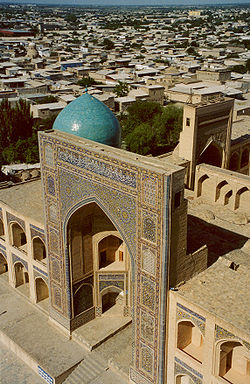[Chelsea Bracci]
Bukhara is the capital of the Bukhara Province of Uzbekistan and is one of the most complete examples of a medieval city in Central Asia. Situated on the Silk Road, Bukhara is over twenty five centuries old. Throughout the city east meets west as Muslim and Soviet influences have left their mark on the landscape of the city.
Prior to the Arab conquest, Bukhara owed its prosperity to its location at the crossroads of highly traveled trade routes and became a major cultural center of the Caliphate of Baghdad. Genghis Khan’s Mongol horde sacked the city in 1220, bringing this period of economic and cultural growth to a halt. From the occupation by nomadic Uzbek tribesmen led by Khan Sheibani to a long period of short-lived dynasties ruled by an emir; there was great internal unrest within Bukhara (Big Soviet Encyclopedia).
 In 1868 the Russian Empire forced the Emirate of Bukhara to accept protectorate status. Over the following forty years the Russian Empire eroded away at the surrounding areas of Bukhara but never annexed the city. Inspired by the Young Turks of the Ottoman Empire, a group of disaffected youth emerged within Bukhara that gravitated towards Pan-Turkism, which is a blend of Islamic and Bolshevik ideas. As during the first few years of the Russian Revolution when Lenin relied on a policy of encouraging local revolutions with the backing of the local bourgeoisie, in the early years of Bolshevik rule the Communists sought the assistance of local groups to encourage revolutions from within. In Bukhara this ideological group became known as the “Young Bukharians” and was led by Faizullah Khojaev. The conflict that ensued lasted for ten years and pitted the secular young Bukharians against the conservative supporters of the Emir. In March 1919 activists of the Young Bukharians informed the Bolsheviks that the Bukharians were ready for the revolution and wanted to be liberated. However, when the Red army arrived at the gates of Bukhara they discovered that the majority of Bukharians did not support an invasion. After the Red army demanded the emir surrender the city to the Young Bukharians the emir murdered not only the Bolsheviks who were residing in the city but several hundred Russian inhabitants living in the city and surrounding areas. The Red army, which had not anticipated such a strong defense, was forced to retreat back to the Soviet stronghold of Tashkent (Big Soviet Encyclopedia).
In 1868 the Russian Empire forced the Emirate of Bukhara to accept protectorate status. Over the following forty years the Russian Empire eroded away at the surrounding areas of Bukhara but never annexed the city. Inspired by the Young Turks of the Ottoman Empire, a group of disaffected youth emerged within Bukhara that gravitated towards Pan-Turkism, which is a blend of Islamic and Bolshevik ideas. As during the first few years of the Russian Revolution when Lenin relied on a policy of encouraging local revolutions with the backing of the local bourgeoisie, in the early years of Bolshevik rule the Communists sought the assistance of local groups to encourage revolutions from within. In Bukhara this ideological group became known as the “Young Bukharians” and was led by Faizullah Khojaev. The conflict that ensued lasted for ten years and pitted the secular young Bukharians against the conservative supporters of the Emir. In March 1919 activists of the Young Bukharians informed the Bolsheviks that the Bukharians were ready for the revolution and wanted to be liberated. However, when the Red army arrived at the gates of Bukhara they discovered that the majority of Bukharians did not support an invasion. After the Red army demanded the emir surrender the city to the Young Bukharians the emir murdered not only the Bolsheviks who were residing in the city but several hundred Russian inhabitants living in the city and surrounding areas. The Red army, which had not anticipated such a strong defense, was forced to retreat back to the Soviet stronghold of Tashkent (Big Soviet Encyclopedia).
On September 2 1920, the Red army returned to the gates of Bukhara, this time prepared to take the city and overthrow the emir. After four days of fighting the Bolsheviks took control of the city and the Soviet flag was raised from the top of the Kalyan Minaret. The emir was replaced by the Council of National Nazirs which was presided over by Faizullah Khojaev. In terms of Soviet terminology the Bukharian People’s Republic was a “revolutionary-democratic dictatorship of the proletariat and the peasantry” which is a transition stage to a Soviet Socialist Republic. The new constitution adopted in September 1921, it allowed private ownership of land and productive assets and granted voting rights to non-proletarians (although relatives of the deposed emir, former emirate officials, and large landowners could not vote). The overthrow of the emir was the impetus for the Basmachi Revolt, a conservative anti-communist rebellion. In 1922 most of the territory of the republic, mainly east Bukhara, was controlled by Basmachi and it took the Red Army until 1926 to fully suppress the revolt (Alimov). The Bukharian People’s Soviet Republic existed from 1920 to 1925, but was absorbed into the Uzbek Soviet Socialist Republic in 1926.
During the Soviet period, Islam became a focal point for the anti-religious drives of Communist authorities. The government closed many of the mosques across Uzbekistan, including Bukhara, and religious schools became anti-religious museums. The Communist Party was the only legal party in the Uzbek SSR until 1990. With the final collapse of the Soviet Union, the Uzbek SSR became the independent nation of Uzbekistan (Alimov).

_______________________________________________________________
Works Cited:
- Afif Alimov,Uzbekistan; Another Big Leap Forward. (London; Soviet Booklets, 1960) http://www.archive.org/details/UzbekistanAnotherBigLeapForward
- Bukharan People’s Soviet Republic, Big Soviet Encyclopedia on-line edition. http://en.academic.ru/dic.nsf/enwiki/1066942#sel=29:1,38:3
- Fitzroy MacLean, Eastern Approaches (Penguin Global,1999).